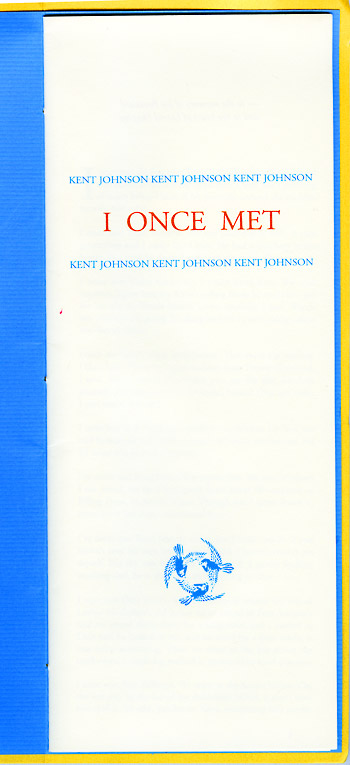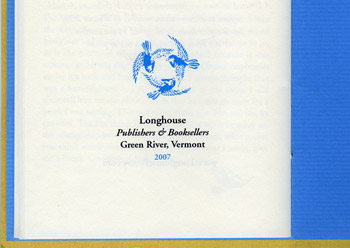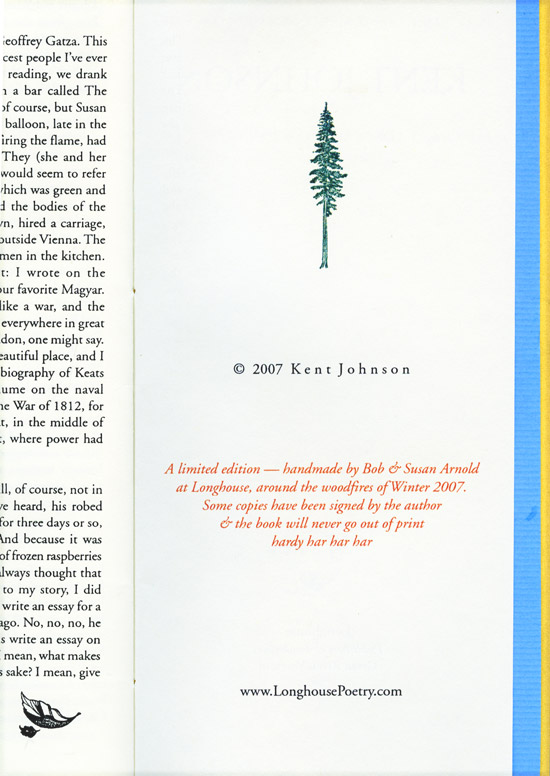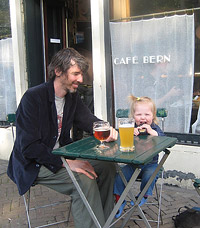
| Jacket 36 — Late 2008 | Jacket 36 Contents page | Jacket Homepage | Search Jacket |
The Internet address of this page is http://jacketmagazine.com/36/r-johnson-met-rb-cralan.shtml
Kent Johnson
I Once Met
reviewed by Cralan
2007 Longhouse, Green River, Vermont.
This review is about 4 printed pages long. It is copyright © Cralan Kelder and Jacket magazine 2008.See our [»»] Copyright notice.
envoi
‘It is advantageous to an author that his book should be attacked as well as praised. Fame is a shuttlecock. If it be struck at only one end of the room, it will soon fall to the ground. To keep it up, it must be struck at both ends.’ — Doctor Johnson
paragraph 1
In ‘I Once Met’, Kent Johnson exposes himself as the black sheep of the poetry family. In the process he exposes a lot of other people as well. The opening notes are anecdotal, luring readers in with talkative overtones. The more than 80 entries are vivid encounters with fellow poets in North and South America, Russia and Europe, in which icons of American letters are humanised.

2
To call these entries merely ‘encounters’ is selling them short. In this book Johnson records what others have missed. He can reshape your opinion of a poet in a few words by exposing their nature first-hand. His questions and observations make many uncomfortable. Read about poets and their obsessions with celebrities, haggles over honorariums, patronizing remarks, embarrassments, incoherencies and accusations. Read about a poet who inexplicably parks miles away from a reading and other tantalizing events “little known in American poetry”. There are stories of obscenities and foul mouths, poets getting hit on the head, punched in the jaw, crying, hiding from each other, becoming fast friends and making career enemies. This is the underbelly of poetry with appearances by Waldman, Wakoski, Dao, Graham, Ginsberg, Mac Low, Hass, Zamora, Wright, Cardenal, Duncan, and Whalen, to name a few.
3
Here is an example of an entry that gives you a taste of “being there”;
4
I once met the great poet, editor, and translator, Clayton Eshleman. This was in Ypsilanti, at the first conference of Sulfur magazine. I was twenty-eight, or something like that. It was a long time ago. I said, Your poetry and translation have been very important to me, Mr. Eshleman. And Sulfur magazine, I said, this to me is the greatest magazine of all time, thank you for what you do, it’s really meant a lot to me. Well, he said, if you’re serious, send me a check for the complete run and write an essay about it all. If you want to be a poet, you can’t just flatter people and expect to get something out of it. Put your money where your mouth is. And then he walked away and started talking and laughing with Michael Palmer and Rachel Blau DuPlessis. And it’s only now that I can see I should thank him for that heartbreaking rebuke. *

5
One or two sentences at first, the entries gain in momentum culminating in stories of impressive breadth. The shooting-hunting-drinking story with Howard McCord comes to mind, and the mirthful meeting with Carl Rakosi. The Stephen Rodefer and Henry Gould entries are both very moving. The pieces function on different levels, some as poems written in the style of their subjects and others as potential historical records. The entries resemble photographs of private moments that would otherwise be buried in biographies. In the second half of the book an increasingly profound quality is revealed as fundamental themes of love, life, war, death, and identity emerge. Repeated reading exposes subtler themes throughout the book.

6
Fact and fiction are not always easy to disentangle. Whereas some entries are metaphorical references to their subject’s behavior or reputation achieved with hyperbole, others are actual poems. These “outright poem” entries give insight to the fact that the book should be read like poetry, is in fact a collection of poems, and that readers need to keep on their toes, deciding for themselves which entries are real, and to what extent “who really said what”. One give-away is the numerous poets Mr. Johnson has never met:
7
I’ve never met Ron Padgett, but I almost did. I raised my fist before his door and paused. There were cicadas screaming to death in the rich summer trees. Why ruin it, I said, and walked away.
8
Kent Johnson’s role as anti-hero is central. For example, Kent’s relationship to Araki Yasusada and how this has affected his interactions within the world of writing is the subject of several meetings. This complicated subject is addressed laterally through conversations and Kent’s emotions during these conversations. For example:
9
I once met Hua Hsu. This was on a train from Boston. I walked through five cars before I found an empty seat. I noticed he was reading BookForum. What do you do? I said. I write about popular culture and music and teach at Harvard, he said. And where are you going? he said. I’m going to New Haven, they’ve invited me for a talk, I said. Oh, a talk about what, he said. Well, it’s about some poems concerning Iraq which the Yale Poetry Group have, I mean has, been discussing, and also about this other work I am executor for, it’s a bit controversial, a fictional author named Araki Yasusada. Oh, you must be kidding, he said, I’ve been teaching Yasusada for the past three years, my students really love it. And there wasn’t another seat on the whole train.
10
The experience of reading ‘I Once Met’ is like somebody telling you 25 great stories at a party. Stories that you find yourself telling other people, thinking “now where did I hear that?” Readers are rewarded guilty pleasure from a privileged balcony seat. Once the book gets going and you’re hooked, it’s over all too soon. I confess to enjoying myself, secure in the knowledge that I would not be a subject, never having met Mr. Johnson. I also found myself wondering what the targets of the entries might themselves think. Highly recommended — one of the most beautiful Longhouse publications to date. Alternatively, many of its entries are also published in the recent Sixth Series of Origin magazine which is available on a CD from Longhouse.
* Note from Clayton Eshleman: The problem with my entry in the Johnson book is that it is plausible, and believable. But it presents me as a kind of inconsiderate and arrogant person, and while I do not suffer fools lightly, I am, in the context Johnson put me in, friendly and considerate. He now claims that we had that conversation many years ago (about 1987). I have no memory of having met him. If we did meet, and if he asked me about back issues of the magazine, I would have told him that they were available. But his lie is exposed in that a full run was not at all available then — Sulfur ended in 2000, roughly 13 years after we supposedly met. This is not a big issue, but it is annoying, and gratuitously negative.

Cralan Kelder with his daughter Crash
Cralan Kelder pictured here with daughter Crash in Amsterdam where they live. Recent publications include Autobahn Children (Blue Press Books) and French Pastry (Coracle) which documents a trip across america as seen through the eyes of a politically-minded croissant, and includes lovely illustrations by Erica van Horn.